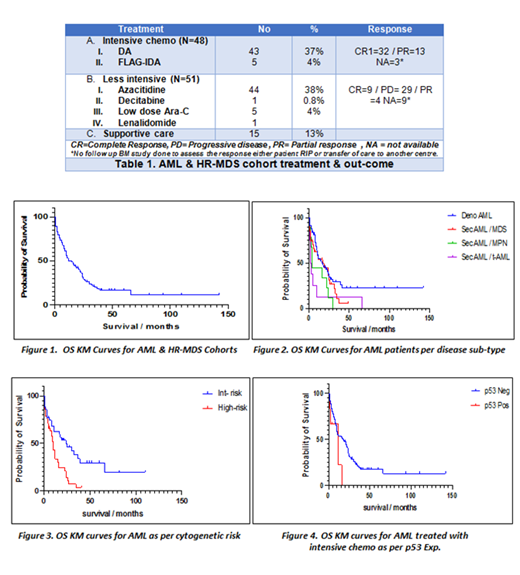Abstract
Introduction: Acute myeloid leukaemia (AML) is a heterogeneous disorder that arises from clonal expansion of malignant hematopoietic precursor cells. Somatic mutations of the p53 gene have been reported in 5-10% of AML, with a higher incidence therapy-related disease and elderly patients. Alteration or loss of p53 is one of the most powerful independent indicators of poor outcome.
Methods: This is a retrospective analysis of AML & high risk-Myelodysplastic syndrome (HR-MDS) patients treated over the study period (2006-2020). Informed consent was obtained. Initial presentation, treatment response, and survival were analysed. Percentage of p53 expression (a surrogate marker for TP53 mutations) by immunohistochemistry (IHC) (>30% cut-off) on BM trephines was analysed and its impact on treatment outcome was evaluated.
Results: We identified 114 patients (AML=104 & HR-MDS=10), the median age was 70 years (Range 36-85) with male predominance (M=73 vs. F=41). The AML group included, 57 patients (50%) with Denovo AML and 47 patients (41%) with Secondary AML (MDS=27, MPN=12 / JAKII mutation =7, t-AML=8). The median age was 70 years (Range 36-85) and the median blast count was 70% (Range 25-95%). Cytogenetic analysis reports were available on 78 patients (75%)(Poor risk=40 vs. Intermediate risk=38). NPM1 (22 patients) and FLT3 mutations analysis (33 patients )were available and reported as positive in 4(18%) and 5(15%) patients respectively.
The HR-MDS is defined by patients who fall into higher-risk group categories in the original or revised IPSS (N=10), the median age was 74 years (Range 63-83) with male predominance (M=7 vs. F=3). The median blast count was 15% (Range 11-18%). Cytogenetic risk prognostic subgroup results were available on 6 patients (60%), 2 patients (2%) had intermediate-risk and 4 patients (4%) had poor-risk.
Ninety-nine patients (87%) were eligible for treatment, 48 patients (42%) were treated with intensive induction chemotherapy, and 51 patients (45%) received less intensive therapy (HMA / LD-Ara C). Five patients (4%) consolidated with allogeneic stem cell transplant (Allo-SCT) post-induction therapy. The remaining (15 patients) were on supportive care. Forty-one AML patients (36%) relapsed post CR1, 3 patients had Allo-SCT in CR2. Table 1
At the time of study analysis (31/01/2021), 25 patients (22%) are still alive including 23 patients (20%) with AML (Denovo AML=18 & Sec AML=5) and 2 patients (4%) with HR-MDS. The median age of the survival group was 69 years (Range 51-83). The whole study cohort median OS was 12 months. (Figure. 1) The median OS & PFS for AML patients were 15 & 13 months respectively. According to AML sub-type, t-AML associated with shortest median OS of 2.5 months (P.value 0.0190). (Figure. 2) The median OS was more favourable for intermediate-risk than the high-risk cytogenetic AML, 24 and 10 months respectively (P<00016).(Figure. 3) The HR-MDS group median OS was 22 months.
One hundred and four patient's BM trephines (91%) were available and screened for p53 IHC expression (AML= 96 & HR-MDS =8). Eight samples (8%) showed p53 over-expression, all these samples with underlying AML diagnosis. The remaining 96 samples (92%) were negative for high p53 expression. The majority of p53 over-expressed AML harboured complex cytogenetics, 4 patients with Sec AML, 3 patients with Denovo AML, and 1 patient with t-AML. Most of the patients (5 patients) in this sub-set had a refractory disease to induction therapy, of whom 2 patients (25%) had Allo-SCT consolidation in CR2. Only one patient (12%) is still alive in this sub-group.
The median OS & PFS in p53 wild-type AML cohort was 16 & 13 months respectively, which compared favourably to 12 & 8 months in those with p53 disruptions. The P. values were 0.134 & 0.193, respectively. The impact of the p53 alterations was more pronounced on the AML sub-group treated with intensive chemotherapy (42%), the median OS & PFS in wild-type p53 AML were 24 & 20 months, while in p53 disrupted cohort were 12 & 10 months respectively (P= 0.030)(95%CI of ratio 0.1755 to 1.425) & (P=0.049)( 95%CI of ratio 0.7015 to 5.702).(Figure.4)
Conclusion: In this study we demonstrated the potential role for p53 expression by IHC, which is readily available in routine practice, in assessing AML prognosis. Our real-life data confirms the dismal prognosis of p53 alterations in this disease. Participation in clinical trials based on genetic risk stratification is warranted.
No relevant conflicts of interest to declare.


